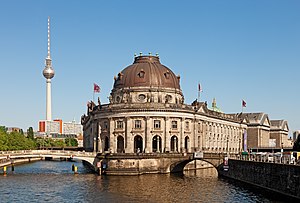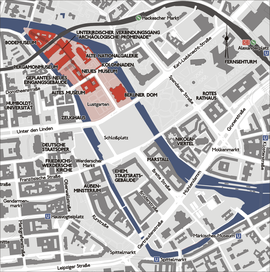Berliner Museen

The Bode Museum at the northern end of Museum Island
|
|
| UNESCO World Heritage Site | |
|---|---|
| Location | Spreeinsel, Q1620888, Mitte, Germany |
| Coordinates | 52°31′17″N 13°23′44″E / 52.521388888889°N 13.395555555556°E |
| Criteria | ii, iv |
| Reference | 896 |
| Inscription | 1999 (23rd Session) |
 Map of Museum Island (in red) |
|
|
[]
|
|
Museum Island (German: Museumsinsel) is the name of the northern half of an island in the Spree river in the central Mitte district of Berlin, Germany, the site of the old city of Cölln. It is so called for the complex of internationally significant museums, all part of the Berlin State Museums, that occupy the island's northern part:
In 1999, the museum complex was added to the UNESCO list of World Heritage Sites.
A first exhibition hall was erected in 1797 at the suggestion of the archaeologist Aloys Hirt. In 1822, Schinkel designed the plans for the Altes Museum to house the royal Antikensammlung, the arrangement of the collection was overseen by Wilhelm von Humboldt. The island, originally a residential area, was dedicated to "art and science" by King Frederick William IV of Prussia in 1841. Further extended under succeeding Prussian kings, the museum's collections of art and archeology were turned into a public foundation after 1918. They are today maintained by the Berlin State Museums branch of the Prussian Cultural Heritage Foundation.
Museum Island further comprises the Lustgarten park and the Berlin Cathedral. Between the Bode and Pergamon Museums it is crossed by the Stadtbahn railway viaduct. The adjacent territory to the south is the site of the former Stadtschloss and the Palace of the Republic.
...
Wikipedia

